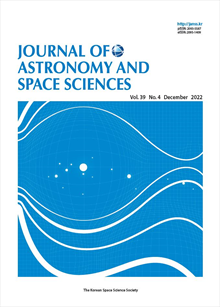간행물
Journal of Astronomy and Space Sciences KCI 등재 SCOPUS

- 발행기관 한국우주과학회
- 자료유형 학술지
- 간기 계간
- ISSN 2093-5587 (Print)2093-1409 (Online)
- 수록기간 1984 ~ 2022
- 주제분류 자연과학 > 천문학 자연과학 분류의 다른 간행물
- 십진분류KDC 443DDC 520
권호리스트/논문검색
제34권 3호 (2017년 9월) 5건
1.
2017.09
서비스 종료(열람 제한)
We present simulations of the optical-band images of high-redshift galaxies utilizing 845 near-ultraviolet (NUV) images of nearby galaxies obtained through the Galaxy Evolution Explorer (GALEX). We compute the concentration (C), asymmetry (A), Gini (G), and M20 parameters of the GALEX NUV/Sloan Digital Sky Survey r-band images at z ~ 0 and their artificially redshifted optical images at z = 0.9 and 1.6 in order to quantify the morphology of galaxies at local and high redshifts. The morphological properties of nearby galaxies in the NUV are presented using a combination of morphological parameters, in which early- type galaxies are well separated from late-type galaxies in the G–M20, C–M20, A–C, and A–M20 planes. Based on the distribution of galaxies in the A–C and G–M20 planes, we examine the morphological K-correction (i.e., cosmological distance effect and bandshift effect). The cosmological distance effect on the quantitative morphological parameters is found to be significant for early-type galaxies, while late-type galaxies are more greatly affected by the bandshift effect. Knowledge of the morphological K-correction will set the foundation for forthcoming studies on understanding the quantitative assessment of galaxy evolution.
2.
2017.09
서비스 종료(열람 제한)
Alexander V. Yushchenko, Yeuncheol Jeong, Vira F. Gopka, Svetlana V. Vasil’eva, Sergey M. Andrievsky, Volodymyr O. Yushchenko
A high resolution spectroscopic observation of the red supergiant star RM_1-390 in the Large Magellanic Cloud was made from a 3.6 m telescope at the European Southern Observatory. Spectral resolving power was R=20,000, with a signal-to-noise ratio S/N > 100. We found the atmospheric parameters of RM_1-390 to be as follows: the effective temperature Teff = 4,250 ± 50 K, the surface gravity log g = 0.16 ± 0.1, the microturbulent velocity vmicro = 2.5 km/s, the macroturbulence velocity vmacro = 9 km/s and the iron abundance [Fe/H] = -0.73 ± 0.11. The abundances of 18 chemical elements from silicon to thorium in the atmosphere of RM_1-390 were found using the spectrum synthesis method. The relative deficiencies of all elements are close to that of iron. The fit of abundance pattern by the solar system distribution of r- and s-element isotopes shows the importance of the s-process. The plot of relative abundances as a function of second ionization potentials of corresponding chemical elements allows us to find a possibility of convective energy transport in the photosphere of RM_1-390.
3.
2017.09
서비스 종료(열람 제한)
During the last glacial–interglacial transition, there were multiple intense climatic events such as the Bølling–Allerød warming and Younger Dryas cooling. These events show abrupt and rapid climatic changes. In this study, the climate events and cycles during this interval are examined through wavelet analysis of Arctic and Antarctic ice-core 18O and tropical marine 14C records. The results show that periods of ~1383–1402, ~1029–1043, ~726–736, ~441–497 and ~202–247 years are dominant in the Arctic region, whereas periods of ~1480, ~765, ~518, ~311, and ~207 years are detected in the Antarctic TALDICE. In addition, cycles of ~1019, ~515, and ~209 years are distinct in the tropical region. Among these variations, the de Vries cycle of ~202–209 years, correlated with variations in solar activity, was detected globally. In particularly, this cycle shows a strong signal in the Antarctic between about 13,000 and 10,500 yr before present (BP). In contrast, the Eddy cycle of ~1019–1043 years was prominent in Greenland and the tropical region, but was not detected in the Antarctic TALDICE records. Instead, these records showed that the Heinrich cycle of ~1480 year was very strong and significant throughout the last glacial–interglacial interval.
4.
2017.09
서비스 종료(열람 제한)
The deep space orbit determination software (DSODS) is a part of a flight dynamic subsystem (FDS) for the Korean Pathfinder Lunar Orbiter (KPLO), a lunar exploration mission expected to launch after 2018. The DSODS consists of several sub modules, of which the orbit determination (OD) module employs a weighted least squares algorithm for estimating the parameters related to the motion and the tracking system of the spacecraft, and subroutines for performance improvement and detailed analysis of the orbit solution. In this research, DSODS is demonstrated and validated at lunar orbit at an altitude of 100 km using actual Lunar Prospector tracking data. A set of a priori states are generated, and the robustness of DSODS to the a priori error is confirmed by the NASA planetary data system (PDS) orbit solutions. Furthermore, the accuracy of the orbit solutions is determined by solution comparison and overlap analysis as about tens of meters. Through these analyses, the ability of the DSODS to provide proper orbit solutions for the KPLO are proved.
5.
2017.09
서비스 종료(열람 제한)
The energy balance in a satellite needs to be designed properly for the satellite to safely operate and carry out successive missions on an orbit. In this study, an analysis program was developed using the MATLABⓇ graphic user interface (GUI) for nanosatellites. This program was used in a simulation to confirm the generated power, consumed power, and battery power in the satellites on the orbit, and its performance was verified with applying different satellite operational modes and units. For data transmission, STKⓇ-MATLABⓇ connectivity was used to send the generated power from STKⓇ to MATLABⓇ automatically. Moreover, this program is general-purpose; therefore, it can be applied to nanosatellites that have missions or shapes that are different from those of the satellites in this study. This power simulation tool could be used not only to calculate the suitable power budget when developing the power systems, but also to analyze the remaining energy balance in the satellites.

